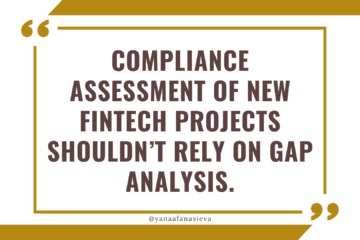FinTech Compliance and Shooting Range: It’s All About FOCUS
It was my first ever visit to a Shooting Range and before I actually got to hold a gun, it’s mandatory to follow and fully internalize a few key instructions. These instructions are so simple and useful, I feel that anyone working in FinTech must apply those immediately:
- Treat any gun as if it’s loaded because most accidents happen when people assume that the gun is empty => This is exactly the same in FinTech security: you should treat every customer as if they have very little tech experience, they may have a weak password and they don’t recognize phishing or human engineering. Educate your customers, but make it quick, efficient, and give them the info they need to know without overwhelming them with long complex legal language.
- Don’t do unnecessary movements with the gun, such as pointing at various objects or humans, scratching your head, or weightlifting => no multitasking. The same applies to FinTechs – most FinTech compliance experts are overloaded because they try to implement too many policies, too many controls, and too many processes, they review too many tools and multitask too much.
- Remove your finger from the trigger until the second you are ready to shoot => it’s good for the safety of the environment and it’s good for your own results since you will know when you need to focus and hit the 10. I feel it perfectly relates to FinTech in the sense that people often see too many risks and try to prepare for too many eventualities and adverse outcomes that may never happen, which dilutes their focus. In the end, when you really need to act fast, your attention and energy might be depleted and your focus is in the wrong place.
Compliance is never about knowing laws or regulations and all about your ability to get results in 4 key areas:
- Managing licensing and partnerships projects and getting them approved
- Optimizing customer experience with respect to technology, onboarding and transaction monitoring to ensure that compliance requirement don’t lead to lost or unhappy customers.
- Navigating inspections and audits, so that they don’t result in redundant obligations to fix things that don’t need fixing and don’t add items to your technical debt.
And…
…there is one more area that feels simple and obvious, but it takes up the majority of the team’s time and can completely paralyze all other activities… which is Internal and External Reporting.
Compliance reporting is important because it generates and keeps up-to-date a lot of mandatory documents that you send to your board, investors, regulators, and auditors, and but despite the fact that this activity is regular, it usually gets worse instead of getting better and more efficient.
Most struggling compliance officers, unfortunately, fall into the same trap: the longer they practice compliance reporting, the more time they need (and not just for themselves, but also from other teams that are supposed to contribute). Misery loves company.
It happens every time, when you don’t follow a clear and simple structure of what to disclose and in which order, and you reinvent your reporting during each reporting cycle, “trying to make it better”. Once you master this structure, you can re-use previously created documents and never overthink what else to say in each section.
It’s very similar to a renovation project that does not have clear boundaries. It feels you can never complete it, it’s never good enough, there is always more to do and more things to fix, and at some point you just have to quit it, because you’ve had enough, it took forever and way beyond your original budget.
How do you know you lack FOCUS and at risk of missing your TARGET with 2020 year-end compliance formalities?
- You created a list of what needs to be done by the year-end, and at each executive meeting the list gets longer and longer and you find more things to do, but nothing actually gets done.
- You feel like you cannot find the right “owner” for this project within your company and for some reason, you believe that you need one.
- Your compliance team has declined, delayed, or denied clients or project feedback, business support, or otherwise ignored revenue-generating requests because they need to “focus on annual reporting” for the next few weeks.
- Everyone is involved in this compliance reporting emergency (including finance, HR, engineering, and customer support teams) and it feels like everyone is running out of time, money, and patience; and nobody currently has any clear ideas on what to prioritize or what’s the right level of details: is it a 5-pager or 500-pager challenge?
If you find yourself in any of the scenarios above – I can help you re-focus in 2 hours on November 24th and November 25th (no violence of any kind, promise!)
AGENDA
Day 1:
- Annual MLRO reporting, key reportable AML metrics to help you prepare for AML audits;
- Annual Risk Assessment (template included) and Risk Acceptance Framework
Day 2:
- Execution of the Compliance Plan (template included)
- Effectiveness of the Internal Controls Framework
- Reporting incidents and special events (Covid, Brexit …)
INCLUDED TEMPLATES:
- Annual MLRO Report Sample
- Annual Enterprise Risk Assessment Template
- Annual Compliance Plan Execution Template language
- Sample disclosures on the Effectiveness of the Internal Controls
- Sample Disclosures for incidents and adverse events reporting
Sign up HERE!

As a bonus – here is a little sneak peek at my first shooting lesson!


